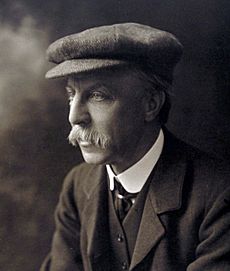Edward Albert Sharpey-Schafer facts for kids
Quick facts for kids
Sir Edward Albert Sharpey-Schafer
|
|
|---|---|
 |
|
| Born | 2 June 1850 |
| Died | 29 March 1935 (aged 84) North Berwick, East Lothian, Scotland, UK
|
| Alma mater | University College London |
| Known for | Insulin, endocrine |
| Awards | Royal Medal (1902) Copley Medal (1924) Cameron Prize for Therapeutics of the University of Edinburgh (1934) |
| Scientific career | |
| Fields | Physiology |
| Institutions | University of Edinburgh University College London |
| Doctoral advisor | William Sharpey |
Sir Edward Albert Sharpey-Schafer (born June 2, 1850 – died March 29, 1935) was an important British physiologist. A physiologist is a scientist who studies how living things work.
He is known as one of the founders of endocrinology. This is the study of hormones and the glands that make them. In 1894, he and George Oliver discovered adrenaline. Adrenaline is a hormone that helps your body react to stress. He also created the word "endocrine" for the special glands that release hormones directly into your blood.
Sharpey-Schafer also came up with the word "insulin". He believed that a missing substance from the pancreas caused diabetes mellitus. Insulin is now known to be that substance. His method for artificial respiration (helping someone breathe) is also named after him.
Contents
About His Life
Edward Albert Schäfer was born in Hornsey, London, in 1850. He was the third son of James William Henry Schäfer, a merchant from Germany, and Jessie Brown, who was English. His family lived in Highgate, a part of north-west London.
Edward went to Clewer House School. In 1868, he started studying medicine at University College London. There, he learned from a famous physiologist named William Sharpey. Edward became the first "Sharpey Scholar" in 1873.
In 1877, Sharpey-Schafer told the Royal Society about something he found in jellyfish. He thought there were tiny gaps between nerve cells. These gaps were later called nerve synapses. The Royal Society didn't believe him at first. But later, in 1888, another scientist, Santiago Ramón y Cajal, proved that these gaps existed. This discovery was very important for understanding how our brains work.
Sharpey-Schafer became an Assistant Professor in 1874. He was made a Fellow of the Royal Society in 1878 when he was only 28 years old. He later became a professor at University College London. In 1899, he moved to the University of Edinburgh to lead the physiology department. He stayed there until he retired in 1933.
In 1900, he was chosen as a Fellow of the Royal Society of Edinburgh. He was also the president of this society from 1929 to 1934.
He was a founding member of the Physiological Society. From 1908 to 1933, he edited the Quarterly Journal of Experimental Physiology. He received many awards and honors for his work. One of his books, Essentials of Histology, was very popular and had many editions. He was also one of the first to use extracts from the adrenal gland in medicine.
King George V made him a knight in 1913. This meant he could use "Sir" before his name.
Sir Edward Albert Sharpey-Schafer passed away at his home in North Berwick on March 29, 1935.
Family Life
Sir Edward was married twice. His first wife was Maud Dixey, whom he married in 1878. After she died in 1896, he married Ethel Maud Roberts in 1900. He had four children from his first marriage. Sadly, he outlived three of them. His eldest daughter died in 1905. Both of his sons died fighting in World War I.
After his eldest son, John Sharpey Schafer, died, Edward added a hyphen to his name. From 1918, he became Sharpey-Schafer. He did this to remember his son and to honor his old teacher, William Sharpey.
His grandson, Edward Peter Sharpey-Schafer, also became a famous professor of medicine.
His Students
Some of his students included James Davidson Stuart Cameron and Alexander Murray Drennan.
Key Contributions and Works
Sir Edward Albert Sharpey-Schafer wrote many important papers and books. He studied muscles, blood, and how our bodies absorb things. Here are some of his main books:
- A Course of Practical Histology (1877)
- Essentials of Histology (1885)
- Advanced Text-Book of Physiology by British Physiologists (1898)
- Experimental Physiology (1910)
He also helped edit Quain's Elements of Anatomy.
Schaefer's Method (Artificial Respiration)
This is a way to help someone who has stopped breathing. Here's how it works:
- The person lies on their stomach with their forehead resting on one arm.
- You kneel over them, with your knees on either side of their hips.
- You press firmly with both hands on their lower back, over their ribs.
- Then, you slowly raise your body, taking the pressure off their back.
- You repeat this pressing and releasing movement about every five seconds. This helps air move in and out of their lungs.
Images for kids



